Chicago of the 1910's and 20's was a center for the creation and production of advertising and calendar art. Many popular themes – the all-American family at home; children at play; cute kids with their cute pets- called for appealing children who could take direction, and project a sense of comfort and naturalness in front of the camera. Beatrice Tonnesen, a foremost creator of advertising and calendar art, was always on the lookout for promising child models.
Around 1913, she spotted three-year-old, blond Betty Crowe, who was riding a streetcar with her mother. Her recruitment of Betty turned out to be a bonanza for Tonnesen: Betty had a cousin, handsome five-year-old William Redmond, who accompanied Betty and her mother to a photo shoot one day. His visit marked the start of a modeling career that spanned more than a decade.
In early 2007, I located Redmond's daughter, Mary, who had saved a variety of mementoes from her dad's childhood modeling days. Among her collection were photos with notations identifying their studios of origin, and old advertisements featuring a number of Tonnesen models. These have been valuable resources in my efforts to identify Tonnesen's works.
Mary also introduced me to Betty Crowe, who at 96, was still charming and eager to talk about modeling for Beatrice Tonnesen. Information I've gathered from talking with Betty and from access to William Redmond's mementoes, including an oral history, is presented in each of their stories below. To see images from their modeling days, please see Slideshow 8. Additional images of William and Betty appear in Slideshows 1, 2 and 4.
Betty Crowe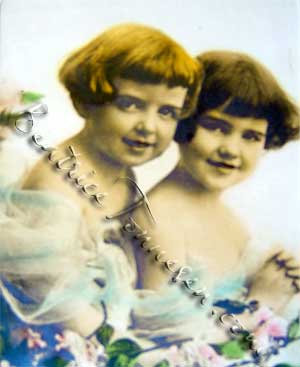
I visited with Betty Crowe in July, 2007. Incredibly, she was still recognizable as the cheery little girl of ninety-plus years ago! She wore her still-blond hair in the same short bob, and she flashed the same bright smile that once lit up Tonnesen's photos.
Betty told me that she modeled for four years, until her family left the Chicago area. She remembers the lady photographer (Tonnesen) as “a real nice lady who loved children.” This, she said, inspired the children to “do their very best posing.”
Betty said the photographer would bring in clothes for the children and “the girls always got bows on their socks.” To help them get into their poses, the photographer would first tell a story, then retreat behind the camera while the models assumed their roles.
Although she only modeled until about the age of seven, Betty has some memories of specific events:
- She remembers modeling for ads for Buster Brown Shoes and Bradley Knits.
- She remembers a day when a group of models visited a forest preserve. A young boy, a baby and a woman went with Betty. Betty can't remember any of their names, but she refers to the woman as “THE Model' and identified her from photos. (See Album 2, Image 1.) At the preserve, Betty appeared in a photo in which the boy fished while Betty watched. Betty later heard that the photo was made into an oil painting and sold for $150.
- Betty remembers asking to work with Virginia Waller because the two girls had fun together. At the same time, she affectionately remembers her cousin, Bill Redmond, as a real “stinker.”
- Betty remembers that Miss Tonnesen told her mother, “It isn't that she (Betty) is beautiful, but she's photogenic.” After Betty moved away, the studio continued to call her for jobs, but it was too far to go.
Betty remembers her modeling experience fondly, but she never really missed it. She went on to work for the post office, marry and raise two children. She currently lives with a few other seniors in a private home in a pleasant neighborhood near Chicago. There, she enjoys sitting on the large, covered porch on nice days.
William A. Redmond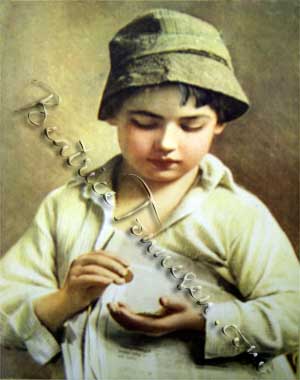
William A. Redmond (1908-1992) modeled well into his teens. He is known to have modeled for the Tonnesen, Keedy and Stadler Studios. A 1986 oral history indicates he worked for others – Underwood and Underwood and Riel – although it is unclear whether he worked as a model or a courier for them, and none of his photos have so far been found marked with their names. William is the only model I've found whose photographic image was used in paintings by two noted calendar artists: R. Atkinson Fox and Rudolph Ingerle.
In addition to his work in calendar art, William modeled for ads for several national companies – Sun-Maid Raisins, Quaker Oats, Johnson Shoes, VanCamp's Beans, to name a few- as well as for Sears and Montgomery Ward catalogues. This exposure led to roles in several commercial motion pictures made by Chicago-based studios to promote national companies.
In his oral history, he reminisced about modeling for still photography. The following excerpt (Illinois General Assembly Oral History Program William A. Redmond Memoir Volume 1, p. 27) is especially interesting to me as a collector of early calendar art, and, I suspect, will also be interesting to antique photography buffs.
“I think one reason I did so much and…lasted so long is that I was small for my age and I could understand and follow instructions probably better than a younger kid…The film wasn't fast enough, so you had to hold still for a certain measurable time. So they had a headrest…they had the old powdered flash lights…they'd ignite it with a spark…and a great big puff would go up and they had a big black thing that they'd put over their head and they'd look in the back of the camera and…they would see the picture and they had a bulb they'd squeeze and have you look here and smile, turn your head this way or that way…”
William A. Redmond went on to earn a bachelor's degree in engineering from Marquette University and a law degree from Northwestern University. He and his wife, Rita, and their three children lived in Bensenville, IL where he practiced law. In 1959, he was elected to the Illinois House of Representatives, serving as Speaker from 1975 until 1980. He resigned his House seat in 1981. His career as a child model was featured in the June 20, 1977 issue of People Magazine. His oral history is available online at www.uis.edu/archives/oral.htm.
Coming Soon: Introducing the Tonnesen Models Part 3. Images and information about other models, most still unidentified but highly recognizable, who starred in Tonnesen’s work.
All Content Copyright 2008 Lois Emerson
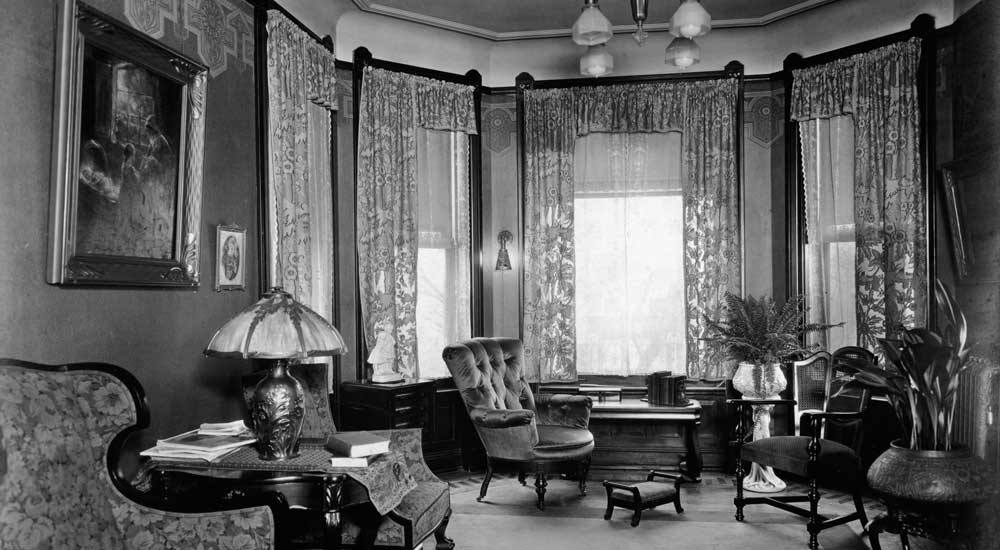

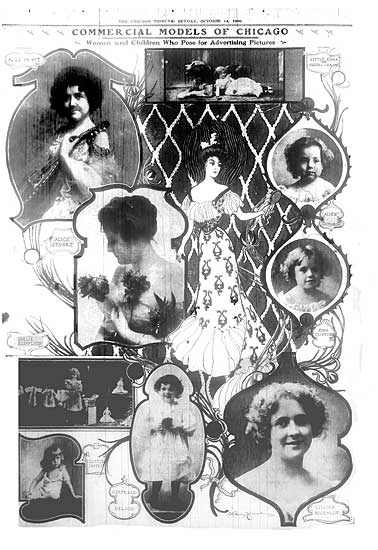
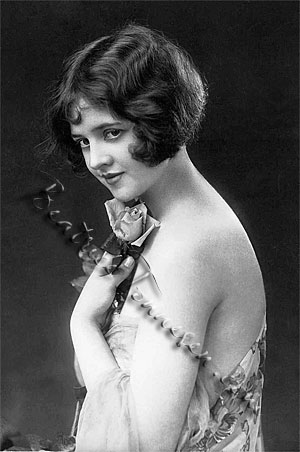

 Julius Schwill died suddenly in 1938. The malt plant was sold to the Falstaff Brewery in the 1960's. Adelyne died in 1984, apparently never remarrying. Obituaries of Adelyne and her three siblings give no indication that any of them had children, so if she had photos or mementos of her modeling career, they may now reside outside the family. See images 20-24.
Julius Schwill died suddenly in 1938. The malt plant was sold to the Falstaff Brewery in the 1960's. Adelyne died in 1984, apparently never remarrying. Obituaries of Adelyne and her three siblings give no indication that any of them had children, so if she had photos or mementos of her modeling career, they may now reside outside the family. See images 20-24.
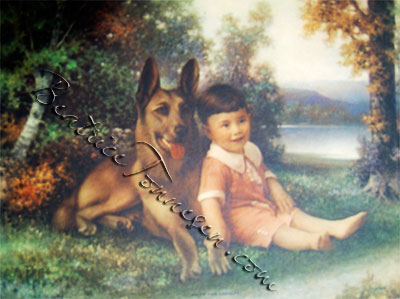 Two prints commonly found on early twentieth century calendars with the signature “A. Pope,” originated as photos by Beatrice Tonnesen. The original photos can be found in the Tonnesen archive of the Oshkosh (WI) Public Museum.
Two prints commonly found on early twentieth century calendars with the signature “A. Pope,” originated as photos by Beatrice Tonnesen. The original photos can be found in the Tonnesen archive of the Oshkosh (WI) Public Museum.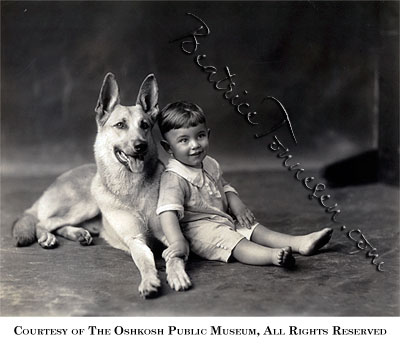 Shown here, below the print titled “Faith and Loyalty,” is the original photo by Beatrice Tonnesen from which “A. Pope” apparently painted. I've included a third print (bottom) which is unsigned, but is done in a style similar to the “A. Pope” prints and which features the same boy and shepherd dog as in “Faith and Loyalty.” The boy wears a straw hat and sits by a battered valise that appear to be the same props used in “The Barefoot Boy” (See Slideshow Album 1), a print by R. Atkinson Fox, that also started as a Tonnesen photo. So I would guess this bottom print, too, began as a photo by Beatrice Tonnesen, although no photo has yet surfaced.
Shown here, below the print titled “Faith and Loyalty,” is the original photo by Beatrice Tonnesen from which “A. Pope” apparently painted. I've included a third print (bottom) which is unsigned, but is done in a style similar to the “A. Pope” prints and which features the same boy and shepherd dog as in “Faith and Loyalty.” The boy wears a straw hat and sits by a battered valise that appear to be the same props used in “The Barefoot Boy” (See Slideshow Album 1), a print by R. Atkinson Fox, that also started as a Tonnesen photo. So I would guess this bottom print, too, began as a photo by Beatrice Tonnesen, although no photo has yet surfaced.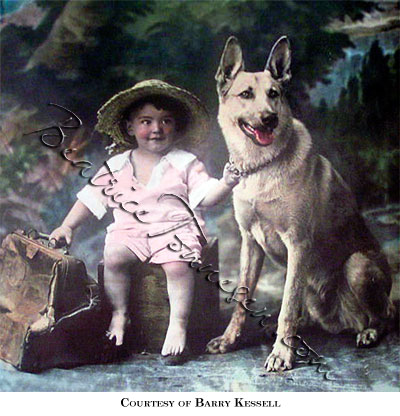 And who is A. Pope? I don't know. I'm not aware of anything signed “A. Pope” except these prints. There was an Alexander Pope (1849-1924) who painted dogs and wildlife. But these prints don't look like A. Pope’s work. Could “A. Pope” be yet another R. A. Fox pseudonym? Could it be a pseudonym for Beatrice Tonnesen? Maybe someone out there knows.
And who is A. Pope? I don't know. I'm not aware of anything signed “A. Pope” except these prints. There was an Alexander Pope (1849-1924) who painted dogs and wildlife. But these prints don't look like A. Pope’s work. Could “A. Pope” be yet another R. A. Fox pseudonym? Could it be a pseudonym for Beatrice Tonnesen? Maybe someone out there knows.

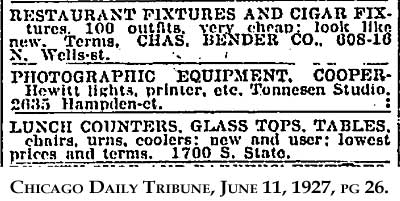
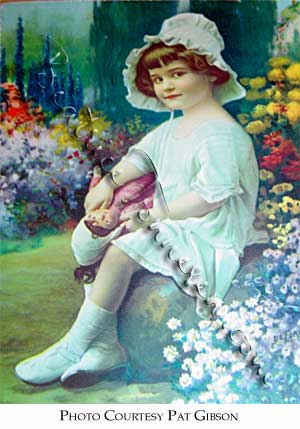 Given her reported work as a modeling agent, it’s quite possible that when we come across the likeness of a Tonnesen model in a work produced by another studio, it is because Tonnesen or someone employed by her, assigned the model to that project. Photographers aren't often identified, either in print ads or in calendar art, but, so far, I have found Tonnesen models in works attributed to four other photography studios of the era: the Keedy, Riel, Stadler and Alsop Studios.
Given her reported work as a modeling agent, it’s quite possible that when we come across the likeness of a Tonnesen model in a work produced by another studio, it is because Tonnesen or someone employed by her, assigned the model to that project. Photographers aren't often identified, either in print ads or in calendar art, but, so far, I have found Tonnesen models in works attributed to four other photography studios of the era: the Keedy, Riel, Stadler and Alsop Studios.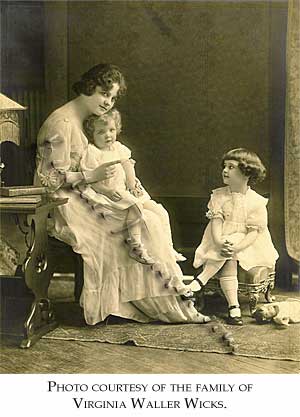 Born March 1, 1913, Virginia Waller (shown here with Jean Blackwell and Janie Burkhhardt/Berkhauer) began modeling when she was only three years old. Her son, Ken, remembers Virginia telling him that she and her mother were shopping in a Chicago store when Beatrice Tonnesen approached and asked if Viginia might be allowed to model for her photos. By that time, Tonnesen had a booming business providing images for print advertising as well as calendar art. Virginia became a familiar figure in the so-called “Cult of Motherhood” genre that was gaining popularity in illustration art in the late teens and 20's. Her short bobbed hair, dainty dresses and patent leather Mary Janes were emblematic of children's fashion of the era. Indeed, in my experience, Virginia seems to have been the most photographed of Tonnesen's child models.
Born March 1, 1913, Virginia Waller (shown here with Jean Blackwell and Janie Burkhhardt/Berkhauer) began modeling when she was only three years old. Her son, Ken, remembers Virginia telling him that she and her mother were shopping in a Chicago store when Beatrice Tonnesen approached and asked if Viginia might be allowed to model for her photos. By that time, Tonnesen had a booming business providing images for print advertising as well as calendar art. Virginia became a familiar figure in the so-called “Cult of Motherhood” genre that was gaining popularity in illustration art in the late teens and 20's. Her short bobbed hair, dainty dresses and patent leather Mary Janes were emblematic of children's fashion of the era. Indeed, in my experience, Virginia seems to have been the most photographed of Tonnesen's child models.